Every conversation, claim, and policy decision in insurance carries regulatory weight. Yet, most compliance teams still audit less than 5 percent of customer interactions, leaving the majority of risks unchecked and undocumented.
That’s not just inefficient. It’s dangerous.
In 2023, a leading US insurer was fined 3.5 million after regulators uncovered non-compliant sales scripts used by third-party agents.
The issue? It wasn’t detected internally because those calls were never reviewed.
This isn’t a one-off. Compliance teams are overwhelmed by volume from thousands of calls, chats, and policy interactions daily, making manual oversight impossible at scale.
Meanwhile, regulators are moving fast. The EU AI Act now requires insurers to ensure transparency, fairness, and ongoing auditability in high-risk AI use cases.
In the US, NAIC guidelines are urging insurers to demonstrate active, explainable oversight of AI and agent-led processes.
Traditional compliance models aren’t built for this. They’re reactive, slow, and heavily reliant on sample-based reviews.
Platforms like Convin bring full visibility into every interaction. They monitor 100 percent of sales and service calls, flag violations in real time, and generate audit-ready insights without expanding your compliance team.
From policy misrepresentation to missing disclosures, automation helps insurers catch issues before regulators do.
In the next sections, we’ll break down where manual compliance falls short, how automation works, and why Convin is purpose-built to help insurers stay ahead of growing regulatory demands.
Smart compliance starts with Convin. Book your demo today!
The Breaking Point of Manual Compliance in Insurance
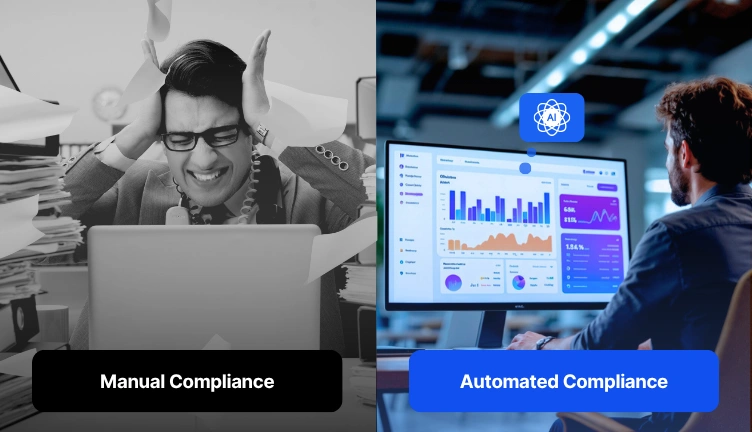
Manual compliance methods are reaching their limits. As insurance regulatory compliance becomes more demanding and data-heavy, traditional processes simply cannot keep up with what the industry requires today.
Key challenges with manual compliance processes:
- Low visibility: Most compliance teams manually review only a small sample of interactions. This creates blind spots across claims processing, underwriting, and customer service.
- Delayed response times: Issues are often detected weeks or months after they occur, increasing the risk of non-compliance.
- High operational cost: Auditing large volumes of data manually requires significant time and resources, affecting overall operational efficiency.
- Inconsistent oversight: Different teams use different standards, which leads to fragmented compliance status tracking across the organization.
Take, for example, a 2023 incident where a US-based insurer was fined 3.5 million dollars for using outdated and misleading policy descriptions in sales calls. The calls had never been reviewed because the company relied on manual audits of less than 2 percent of interactions.
This lack of real-time monitoring resulted in regulatory fines, reputational damage, and lost consumer trust.
Another growing challenge is the constant evolution of compliance requirements. Insurance professionals must stay aligned with new regulations like the EU AI Act and NAIC’s AI governance model, both of which require insurers to implement explainable and auditable AI systems.
Manual methods fall short in meeting these demands because:
- They cannot analyze vast amounts of unstructured data from claims notes, call recordings, and emails.
- Human error introduces risks in documentation and interpretation.
- There’s no scalable way to monitor third-party agents or external vendors in real time.
With insurers operating in such a regulated and data-intensive environment, the risk of compliance gaps, data breaches, or failure to protect sensitive customer information increases significantly.
To overcome this, forward-thinking insurance companies are now adopting AI technology for insurance compliance automation. AI’s ability to process and analyze historical data, identify patterns, and deliver immediate insights makes it ideal for AI audit monitoring.
AI-powered compliance systems provide:
- Automated detection of non-compliant behavior in claims, policies, and conversations.
- Continuous monitoring of all customer-facing and back-office interactions.
- Real-time alerts for compliance officers to act before regulators do.
- Data security measures that protect sensitive customer information across channels.
In the current climate, leveraging AI is about creating a strategic advantage. Manual oversight can no longer match the speed, scale, or precision required to manage risk effectively in the insurance sector.
Discover how manual audits fall short. Convin scales your compliance instantly.
What Modern Regulators Expect from AI-Driven Insurers

As the insurance sector continues to adopt AI across business functions, regulators are raising the bar. The use of AI models for speed and automation is no longer sufficient; insurers must now adhere to regulatory compliance, which requires complete accountability, explainability, and transparency.
Modern regulators expect insurers to go beyond technical performance. They want to see governance frameworks that protect consumers, detect risks early, and ensure fair practices across all AI-powered systems.
Here’s what regulators now require from AI-driven insurers:
- Explainable AI models: Insurers must be able to explain how automated decisions, such as claim rejections or premium pricing, are made. Black-box systems are no longer acceptable.
- Human oversight: AI systems must include mechanisms for human review, especially in high-stakes decisions involving underwriting or claims processing.
- Bias detection and fairness: Regulators are concerned about historical data introducing discrimination. Insurers must demonstrate that their models avoid unfair bias and are regularly tested for accuracy and equity.
- Audit-ready reporting: Continuous, AI-enabled compliance monitoring is expected. Insurers should have tools in place that log AI decisions, flag anomalies, and maintain records for external audits.
For example, under the EU AI Act, AI systems used in insurance pricing or claims handling are classified as high-risk. Insurers operating in the EU must prove that their models meet strict compliance requirements, including documentation, testing, and data protection protocols.
In the US, the National Association of Insurance Commissioners (NAIC) has issued model guidelines urging insurers to adopt robust AI governance practices. These include:
- Regular audits of AI-driven tools and decisions
- Transparent documentation of model inputs and outcomes
- Policies for ensuring data security and consumer protection
Failure to meet these standards can result in financial penalties, loss of license, or reputational damage. Regulators are also increasingly scrutinizing how insurers manage third-party AI tools used by agents, vendors, or external partners.
Key expectations from regulators today:
- Proactive compliance management, not reactive audits
- Real-time insights into compliance status
- Automated monitoring of AI systems for risk detection
- Integration of fraud detection and risk assessment in claims and policy processes
- Transparent and auditable compliance-related processes
As AI becomes central to business processes, compliance teams must evolve their approach. Manual oversight won’t satisfy regulators who now demand real-time monitoring, informed decisions, and continuous proof of compliance.
Insurance compliance AI platforms that offer these capabilities give insurers a clear competitive advantage. By embedding regulatory logic into daily operations, insurers can reduce exposure to non-compliance and operate with greater confidence.
Stay ahead of regulations with AI-powered compliance from Convin.
This blog is just the start.
Unlock the power of Convin’s AI with a live demo.

Core Capabilities of Insurance Compliance Automation with AI
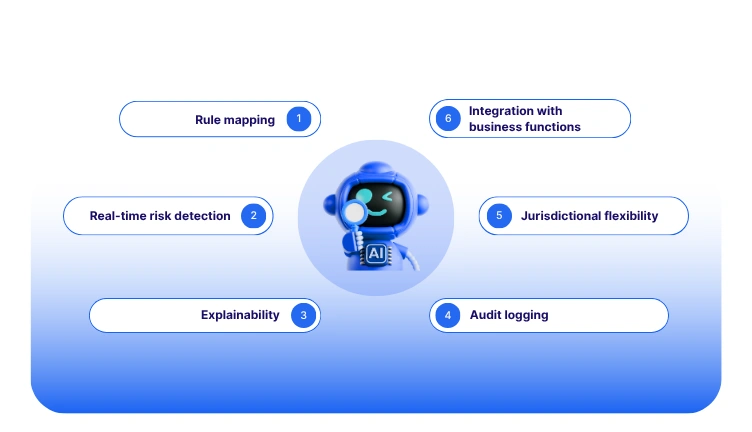
As regulatory demands rise and operational complexity grows, insurance companies are turning to AI to build scalable, accurate, and proactive compliance systems. But automation isn’t just about replacing manual processes. It’s about embedding intelligence into every layer of compliance management.
AI-powered compliance automation offers a range of capabilities that transform how insurers meet both current and emerging regulatory expectations.
1. Real-time monitoring across all interactions
AI systems enable comprehensive monitoring of customer communications, including calls, emails, and chat transcripts, overcoming the limitations of manual audits. They facilitate the detection of policy misstatements and missing disclosures during sales, instantly flag non-compliant behavior in service interactions, and capture violations by third-party agents or vendors.
2. Automated detection of compliance issues
AI tools leveraging machine learning algorithms can scrutinize extensive claims data and customer interactions to detect anomalies, incomplete documentation, and risky patterns. They can also identify deviations from approved underwriting scripts, highlight fraud indicators during claims processing, and reveal gaps in necessary regulatory disclosures.
3. Built-in explainability and audit trails
Regulators require insurers to clarify decision-making processes. Insurance compliance AI tools offer explainability features that ensure fairness and transparency, enabling the generation of instant logs for decisions, creating audit-ready records to meet regulatory standards, and maintaining traceability for audits.
4. Adaptive compliance logic
AI-driven compliance platforms offer real-time updates to accommodate new regulations and market conduct rules, allowing insurers to quickly adapt without needing to overhaul workflows. They enable the integration of jurisdiction-specific compliance rules and allow for customization of alerts and thresholds according to risk appetite.
5. Seamless integration into business functions
AI compliance tools enhance the insurance lifecycle by integrating into sales, claims, underwriting, and customer service workflows. They embed compliance checks directly into processes, trigger alerts for high-risk activities, and reduce reliance on manual follow-ups or post-issue reviews.
Automating routine tasks and analyzing datasets through AI allows insurers to address compliance issues proactively, enhancing risk management, operational efficiency, and customer satisfaction while safeguarding against financial penalties. These capabilities ensure that insurance professionals remain competitive and compliant in a regulatory landscape.
See how Convin delivers real-time risk detection and audit readiness.
Common Compliance Pitfalls AI Helps Avoid
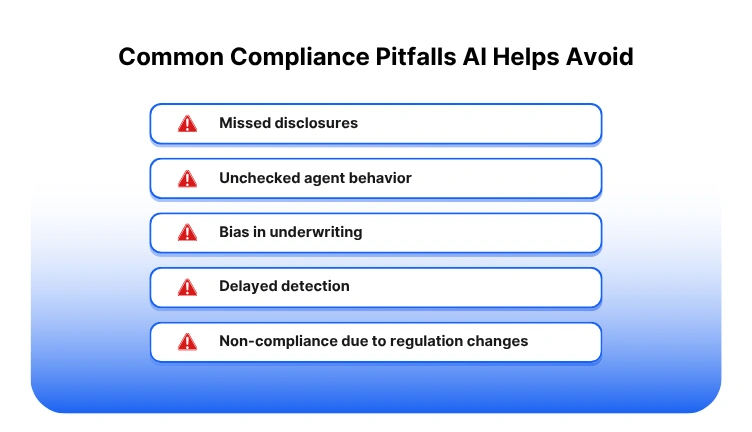
Even well-established insurers face persistent gaps in their compliance processes. With growing regulatory demands, evolving data requirements, and increasing reliance on digital interactions, traditional methods expose insurers to risk.
Insurance compliance automation powered by AI helps eliminate these pitfalls by adding precision, scale, and consistency to compliance efforts.
- Overlooked violations in customer interactions
Manual audits cover only a fraction of customer interactions, allowing misstatements or missed disclosures to go unnoticed. AI systems provide real-time monitoring across all communications, ensuring compliance gaps are identified immediately and reducing exposure to regulatory fines.
- Bias and inconsistencies in decision-making
AI models trained on unchecked historical data can lead to unfair outcomes in underwriting or claims. With embedded bias detection and explainability, AI tools help insurers ensure fair practices and compliance with data protection standards.
- Compliance drift from regulatory changes
Keeping up with evolving regulatory requirements is a major challenge. AI-driven platforms adapt quickly, updating compliance logic in response to changes from regulators like the NAIC or EU bodies, helping insurers maintain compliance status across jurisdictions.
- Limited oversight on agents and third parties
Third-party agents and vendors often operate outside direct internal controls. AI enables insurers to monitor all external-facing processes, enforcing compliance consistently and enhancing fraud detection and risk assessment efforts.
- Delayed issue detection and human error
Manual methods are reactive and prone to error. AI tools enable immediate detection of compliance issues, reduce reliance on sampling, and support more reliable and scalable compliance processes.
By eliminating these common pitfalls, AI empowers insurers to move from reactive compliance to a proactive, data-driven strategy. This not only strengthens risk management but also positions compliance as a driver of operational excellence and trust.
Catch every violation before it becomes a penalty with Convin!
How Convin Powers End-to-End Insurance Compliance Automation
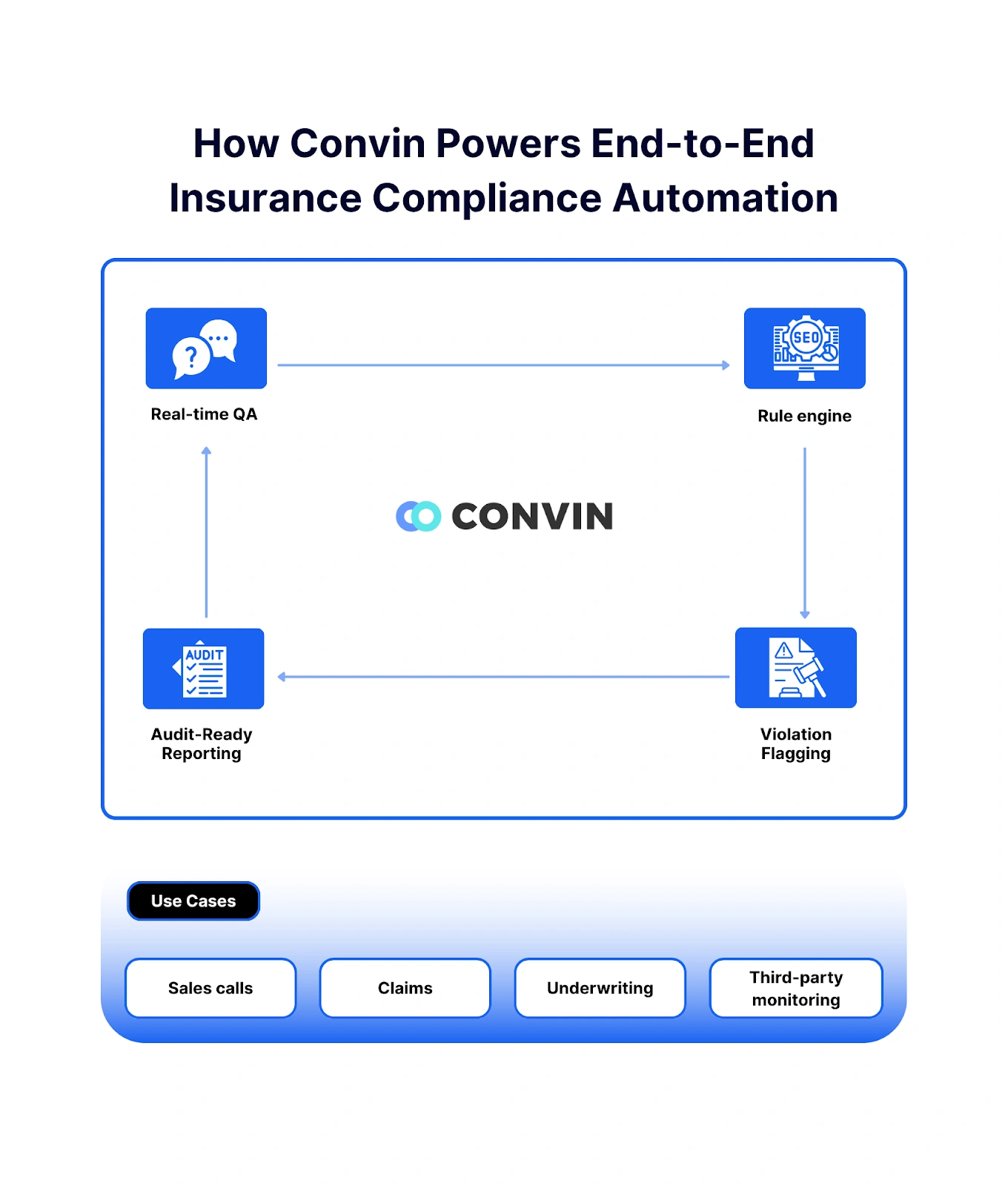
Convin enables insurers to move beyond fragmented audits and siloed monitoring by offering a unified AI solution for full-spectrum compliance automation. From detecting issues in real time to maintaining audit-ready records, Convin supports compliance teams at every step.
- Real-time QA across customer conversations
Convin reviews 100 percent of voice, email, and chat interactions, ensuring full visibility into customer communication. It flags policy misstatements, missing disclosures, and script deviations as they happen, eliminating reliance on sample-based reviews.
- Automated detection of non-compliant behavior
Through advanced AI and machine learning algorithms, Convin identifies anomalies, regulatory violations, and high-risk patterns across sales, service, and claims processes. It ensures compliance teams can act quickly to mitigate risks before they escalate.
- Customizable rule engines and regulatory alignment
Convin’s compliance engine can be tailored to match regional laws, regulatory guidelines, and internal business rules. This makes adapting to regulatory changes seamless and supports consistent enforcement across teams, products, and jurisdictions.
- Audit-ready reporting and traceability
Every flagged issue is automatically documented with time stamps, context, and violation type. This enables compliance officers to produce accurate reports for audits and regulatory reviews without manual preparation.
- Integration across underwriting, claims, and agent workflows
Convin fits into existing business functions without disrupting operations. It monitors agent behavior, supports compliance during claims assessments, and reinforces oversight during underwriting, ensuring governance across the insurance lifecycle.
- Insights to drive continuous compliance improvement
Beyond monitoring, Convin delivers actionable insights into compliance trends, agent performance, and process gaps. This helps insurers strengthen their training programs, refine risk management strategies, and continuously improve compliance posture.
By combining real-time monitoring, intelligent automation, and scalable governance, Convin transforms compliance from a reactive obligation into a proactive, strategic capability for modern insurers.
Automate your entire compliance workflow effortlessly with Convin.
Turning Compliance into a Strategic Advantage
The future of insurance compliance is intelligent, proactive, and fully automated. As regulatory expectations rise and data volumes grow, manual oversight simply cannot keep pace.
AI-powered insurance compliance automation offers the clarity, speed, and control insurers need to stay ahead of risks and regulations.
Convin enables insurers to meet these demands with confidence. By embedding real-time monitoring, automated detection, and audit-ready reporting into every interaction, Convin helps compliance teams eliminate blind spots, adapt to regulatory changes, and operate with integrity at scale.
For insurers ready to close compliance gaps and gain a competitive edge, the next move is clear - make compliance continuous, intelligent, and AI-driven.
Ready to see how Convin transforms compliance? Book a demo now!


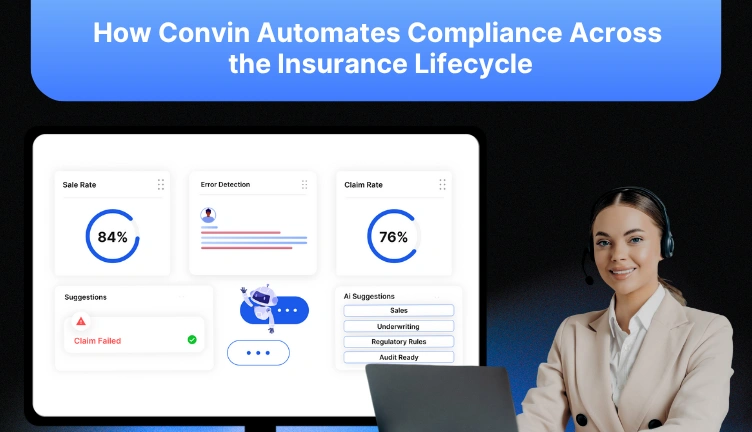

.avif)